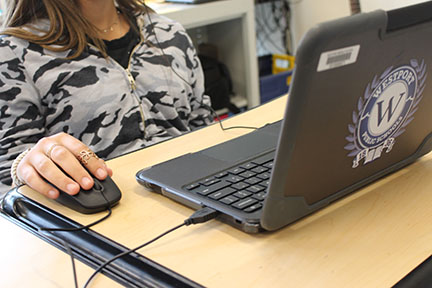Blending Test Prep with Curriculum

Westport administers the SBAC, a computerized test, over three days in May.
In May, the SBACs, Connecticut’s administered standardized test, will be starting in Bedford Middle School. This year, the district has been devoting more time, resources, and focus on practice testing by completing “interim assessment blocks” or IABs.
IABs consist of short tests, ranging from about five to 15 questions, that students take during their math class or language arts periods. The test questions match the SBAC testing format and introduce the same concepts that will be on the SBAC itself. The idea is that students will feel better prepared when they take the scored test.
Principal Adam Rosen said that SBACs contribute important information to the district. “The SBAC is a way for us to assess to what degree our students are capable and understanding of Common Core standards. The SBAC is tremendously important. I want every student at Bedford Middle School to participate; it is a challenging, adaptive test, and doing it is a service to yourself and the school,” said Dr. Rosen.
The SBACs, Common Core state standards, and curriculum are all relatively aligned, according to Dr. Rosen. So, by student participating in the SBAC, the school district can see what their achievement level is in terms of those standards, and how the curriculum needs to be adjusted in order to improve. “The IABs are allowing teachers to make snapshots of students’ performance and make adjustments along the way,” Dr. Rosen said. “The staff is starting to learn a vast amount of what the SBAC is asking us to do, and teachers are looking back at their instruction and asking, ‘Are we really aligned, or are we not?’ This way, we can see how we are performing in certain standards; in some standards we are strong, in other areas we are not.”
More testing and testing preparation has been met with some resistance from students. “IABs are fine, except I prefer to write with paper and pencil and I feel like they take that away from me,” eighth grader Lilli Aldridge said. “The school expects us to improve our ranking on the SBACs, but they didn’t really prepare us for them before; we were kind of just pushed into them with no real preparation.”
In an informal survey conducted on March 20 by asking 20 students what they thought of SBAC prep through IAB, 90 percent of those students believed that standardized testing was not a valuable use of class time.
Additionally, 80 percent said that their teacher had at one point deviated from a certain unit or concept to practice for the SBACs. Only 20 percent said that the state tests were stress-inducing.
Dr. Rosen, however, believes that little is being taken away from the curriculum by including IABs. “It’s quite the opposite,” he said. “We’re using information from the IABs to really enhance the curriculum and figure out the areas in each grade that we’re weak in. I think it’d be really arrogant for a school to think that their curriculum is perfect; because it’s not, but the SBAC helps us understand whether we’re implementing the standards we should be teaching to.”
He also said that next year the district does not plan on conducting IABs or other practice tests. “Next year, our goal is to no longer administer SBAC instruction or IABs in regular classes; we hope that the SBAC will naturally be incorporated into regular teaching.”
Dr. Rosen added as well that the school is, in fact, at a deficit when students choose to opt out of the SBAC because it weakens the validity of the data set. Last year, 42 students refused to comply with state-mandated testing. Dr. Rosen said that there should be no reason for student refusal because the SBACs are simply about collecting information for the school to analyze.
“When students sit down for the SBAC, we want them to be prepared. It’s not about doing well on the SBAC; we want them to, and that’s nice if they do, but it’s more about understanding the curriculum.”


